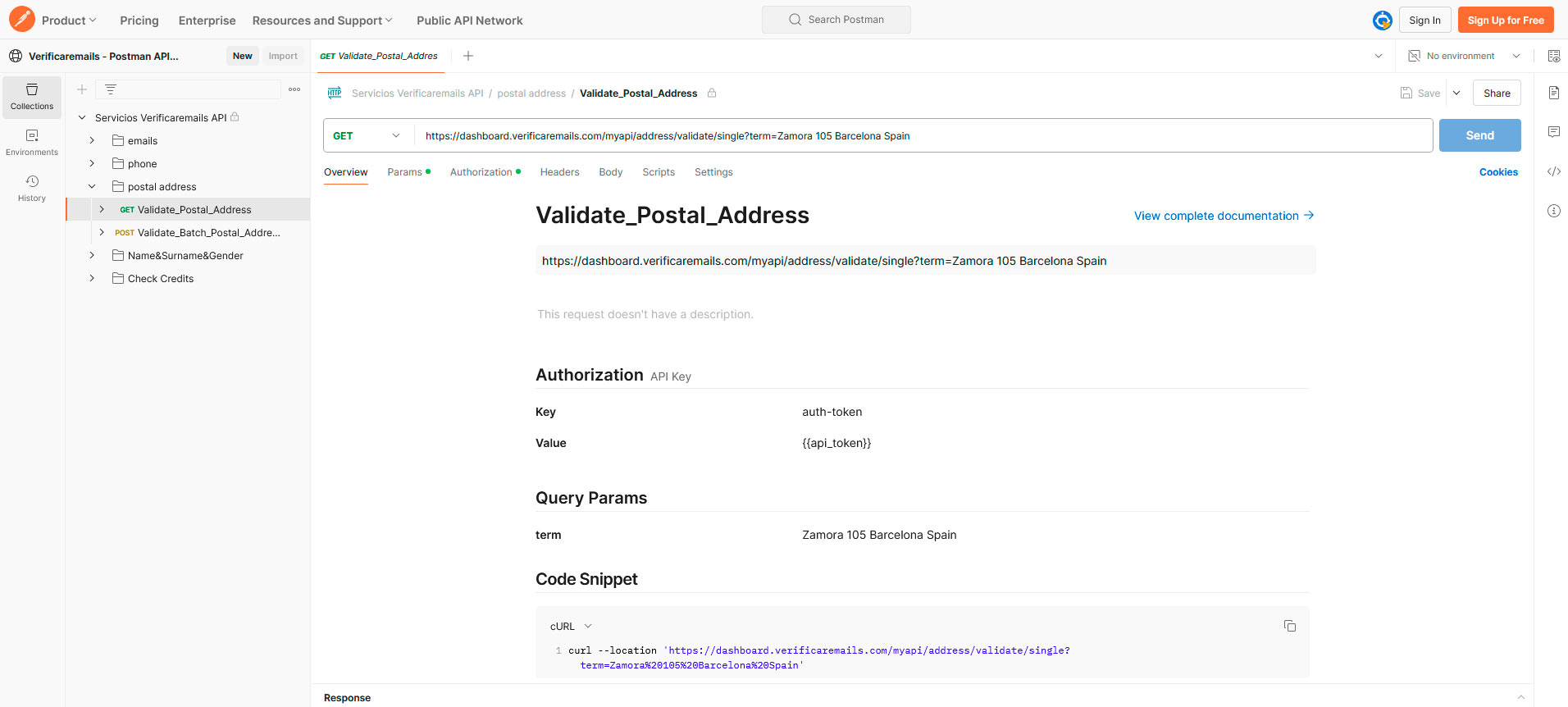In the dynamic world of e-commerce and logistics operations, accuracy in postal address management is more critical than ever. A minor error in one direction can lead to significant delays, additional costs, and a deteriorated customer experience. This is where postal address validation comes in as an invaluable tool, not only to correct errors but also to ensure that deliveries reach their correct destination. The ability to search for coordinates in Google Maps, convert them to UTM coordinates for more technical use, or even enable address autocomplete functions in Android applications are just some of the advantages these APIs offer, ensuring reliable postal addresses and worldwide coverage.
This article delves into the importance of an API for validating postal addresses, describing the main features that such APIs offer, from address verification to geocoding and zip code validation. We will explore how to implement a postal address validation API, detailing the steps necessary for its effective use, as well as different use cases that highlight its applicability and real-world value. For those looking to improve postal address accuracy, avoid delivery errors, and optimize logistics and customer satisfaction, understanding how these APIs work and how they can be integrated into their systems is essential.
Why is address validation crucial?
Address validation, or AV, is essential to optimize logistics and distribution operations, especially in e-commerce. This process not only verifies the accuracy and completeness of a mailing address, but also ensures that it is deliverable by checking it against a database of valid addresses. The following are the reasons why address validation is crucial:
Avoid delivery errors
Address validation helps prevent common delivery errors, such as incorrect or incomplete addresses. These errors can lead to package returns, which generate additional costs and negatively affect the customer experience. By ensuring that each address is correct before proceeding with shipment, these issues are minimized and significant financial losses are avoided.
Improve logistics
Implementing an address validation system significantly improves a company’s logistics. It allows for more efficient planning of delivery routes and can help reduce costs associated with transportation. In addition, ensuring that addresses are accurate and formatted correctly helps to avoid delivery delays, which in turn can reduce the need to handle returns and resolve delivery problems.
Ensure customer satisfaction
Order delivery accuracy plays a crucial role in customer satisfaction. A properly validated address ensures that packages arrive at their destination smoothly, improving the customer experience and increasing the likelihood that customers will do business with the company again. In addition, an effective address validation system can reduce the risk of fraudulent activity and improve the overall security of the delivery process.
By integrating address validation into their systems, companies not only optimize their logistics operations, but also strengthen their customers’ trust and loyalty by ensuring accurate and on-time deliveries.
Main features of a validation API
A postal address validation API offers several key features that are critical to ensuring accuracy and efficiency in address management. These features include verifying the existence of addresses, correcting incomplete addresses, and using appropriate formats. Each of these features plays a crucial role in the validation process and has a significant impact on reducing errors and improving operational efficiency.
Verification of the existence of addresses
The address validation API first checks whether an address actually exists by comparing it against a database of known and validated addresses. This step is essential to ensure that packages are sent only to existing addresses, thus avoiding the costs and complications associated with erroneous shipments.
Correction of incomplete addresses
In addition to verifying the existence of an address, the API also corrects incomplete addresses. This includes adding missing information or correcting incorrect data entered during the entry process. For example, if a zip code or city is missing, the API can fill in these critical details to form a complete and usable address.
Use of appropriate formats
Finally, API ensures that all addresses conform to the appropriate formats according to local and international standards. This may include standardizing terms such as “street” to “C.” or “avenue” to “Avda.” as well as reorganizing the address components to comply with standard formats. This standardization helps ensure that addresses are recognized and handled correctly by shipping and delivery systems.
These features not only improve address accuracy, but also contribute to faster and more reliable delivery, which in turn improves customer satisfaction and optimizes logistics operations.
Steps to use an Address Validation API
Registration and authentication
Select the right API
Before you begin, it is crucial to choose an API that fits your specific address validation needs. Research and compare different APIs to find the one that best suits your requirements.
Get API credentials
Register as a developer on the API provider’s site and get your credentials, which usually include a client ID and an API key. These are essential to authenticate your API requests.
Application integration
Read the API documentation
It is essential to fully understand the documentation provided by the API provider. This will help you to know the technical details such as available endpoints, accepted request parameters and response codes.
Integrate the API into your application
Use a suitable programming language such as JavaScript, PHP, Python, or Node.js to make HTTP requests to the API endpoints. Be sure to follow development and error handling best practices during integration. We recommend that you review POSTMAN where we have code examples for address verification.

Functional tests
Perform thorough testing
After integration, it is crucial to perform detailed tests to ensure that the API works correctly within your application. This includes verifying authentication, data retrieval and manipulation, and error handling.
Monitor application performance
Continually monitors application performance to identify and resolve any issues that may arise due to API integration. This ensures that address validation is handled efficiently and effectively.
These steps will enable you to integrate and use an address validation API effectively, improving the quality of address data and optimizing logistics and customer service operations.
Address validation API use cases
E-commerce
In the e-commerce industry, accurate delivery addresses are critical to avoid package returns and ensure customer satisfaction. By using an address validation API, you can ensure that the addresses entered by customers are correct and complete. This not only reduces the costs associated with returns, but also improves the customer experience by minimizing delivery delays.
Financial Services
For financial institutions, address verification is crucial to comply with regulations and avoid fraud. An address validation API allows these institutions to ensure that their customers’ contact information is up-to-date and accurate. This is especially important for the delivery of sensitive documents and the verification of the customer’s identity in processes such as account opening or loan applications.
Transportation and logistics
In transportation and logistics, efficient route planning is vital to reduce costs and carbon emissions. An address validation API helps optimize delivery routes by ensuring that addresses are accurate. This allows transport companies to plan their routes more effectively, reducing time on the road and contributing to a more sustainable and economical operation.
Conclusion
The implementation of postal address validation represents a fundamental advance in the optimization of logistics operations and customer experience in sectors such as e-commerce, financial services and logistics. Throughout this article, we have explored how these tools significantly improve address management accuracy, reduce delivery errors and contribute to a satisfactory user experience. We have delved into the essential features they offer, such as address verification, error correction and proper format compliance, and outlined the steps necessary for their effective integration and optimal use.
Based on the use cases discussed, it is clear that the significance of an address validation solution goes beyond simple error correction, playing a crucial role in operational efficiency, customer satisfaction, and business sustainability. Although the Postal Address Verification API site provides practical examples, we focus our conclusion on the reflection and synthesis of the article without additional details. By further exploring and adapting these address validation solutions, companies can not only improve their logistics operations but also strengthen their customers’ trust and loyalty, making a difference in an increasingly competitive market.
FAQs
- What does API mean in the context of postal services?
In postal services, API refers to a system that allows users’ postal addresses to be validated, thus avoiding errors in the delivery of orders or in the management of marketing campaigns. - What does it mean to have a verified e-mail address?
A verified email address confirms that the owner of the email address has access to the email inbox. This verification process only needs to be performed once, although the user can have multiple verified email addresses in their account.



